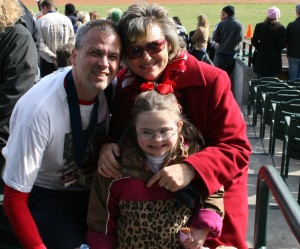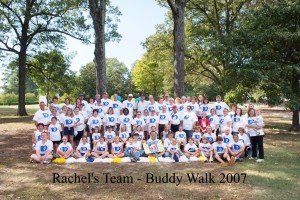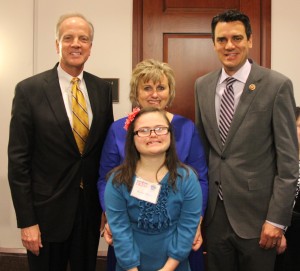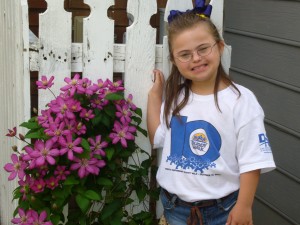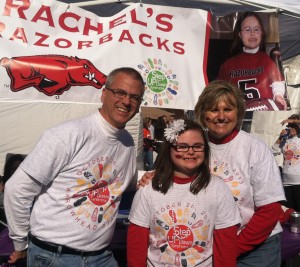Congress is back in session this week. Time for an update. When last we left the ABLE Act, it had unanimously passed the Ways and Means Committee. Next stop House Rules committee and hopefully a September vote to make this law. The ABLE Act’s journey began over seven years ago.
Seems appropriate for me to take a little trip down memory lane and look at ABLE and the Mast family back in 2007 when the bill was first introduced and look at us today. I want to begin by saying that even before Rachel was born we were advised that she could not have more than $2,000 in assets without jeopardizing government supports. You will need to pay money to set up a special needs trust in order to save for her future which, by the way, will probably cost as much as your own retirement. So those of us who need to save the most have to pay money to set up a special needs trust and pay taxes on what is in the trust on an annual basis because we will probably need some government supports to support Rachel’s life? Sounded crazy in 1999 and still sounds crazy in 2014.
In 2007 we were living in Memphis. This is a family picture from Jonathan’s St. Jude marathon in December of that year.
Rachel would finish 1st grade with Mrs. Morphis and start 2nd grade with Mrs. King. She would be in her third and fourth plays at the Bartlett Performing Arts Center. Here she is as a Sea Horse in The Little Mermaid.
This is her team at the Down Syndrome Association of the Mid-South Buddy Walk.
That same year I became the first Executive Director of the Down Syndrome Association of Memphis and the Mid-South. The Financial Savings Accounts For Individuals with Disabilities (FSAID) was first introduced in Congress by Congressman Ander Crenshaw (R-FL) and Senators Bob Casey (D-PA) and Orin Hatch (R-UT). This was the beginning of an almost eight year march to pass a common sense law so individuals with disabilities and their families could save like all other Americans.n This was the beginning of today’s ABLE Act.
Since that time, here’s a little of what’s happened.
- Some version of the ABLE Act has been introduced in four Congresses.
- Jawanda Mast reached out to Tennessee Congressional delegation for support of this legislation.
- The Mast family followed the yellow brick road and moved to Olathe, KS
- One or more members of the Mast family visited Washington DC five times to advocate for this bi-partisan bill and other legislation that would benefit those with Down syndrome.
- There have been many trips to the home offices of the Kansas Congressional delegation.
- The Buddy Walk on Washington and the National Down Syndrome Society (NDSS) Ambassador program was initiated by NDSS as a means of becoming more effective in advocating for federal and state laws that benefit individuals with Down Syndrome.
- In 2012 Rachel made her first trip to Washington DC as self-advocate. She declared to Senator Moran that he needed to co-sponsor the ABLE Act so she could live in a pink house. It has become the symbol of her march toward independence.
- The Achieving a Better Life Experience (ABLE) Act* of 2013 (S. 313/H.R.647) was introduced in the 113th Congress by Senators Robert Casey, Jr., (D-PA) and Richard Burr (R-NC), and Representatives Ander Crenshaw (R-FL), Chris Van Hollen (D-MD), Cathy McMorris Rodgers (R-WA), and Pete Sessions (R-TX).
- Our Senators Jerry Moran (R-KS) and Pat Roberts (R-KS) and Congressman Kevin Yoder (R-KS) are among the 75 Senators and 380 United States Representatives co-sponsoring this bill.
- No bill on the Hill has more bi-partisan support.
In 2007 when the ABLE Act journey started, Rachel turned 8. This year, 2014, she turned 15 and started high school.
She was in her 15th play, Shrek the Musical.
This is our family’s picture from last year’s Down syndrome walk.
It will be only a few short years until Rachel will be pursuing some type of post-secondary program. We hope that involves the University of Arkansas. She’s thinking the University of Kansas and that would be okay too! A few short years later, she will be needing a job and will want to be living in that pink house. Hopefully, she will be able to have a job that helps to pay for most of her needs. Being a realist, I know that she will need some government supports to be able to have post-secondary training, to become independent and live her dreams.
So today I say to Congress, please send the ABLE Act of 2013 to the House and Senate floors for a vote. Show the American people that Democracy can and does work. Show them that you can come together and pass a bill that makes sense. Pass the ABLE Act so Rachel can follow the yellow brick road right to that pink house. The time is now to do the right thing. #passTHEABLEAct and send it to the President’s desk to sign into law NOW!
Give us something to really celebrate during Down Syndrome Awareness Month in October.
#passtheABLEAct now!
* The Achieving a Better Life Experience (ABLE) Act of 2013 (S. 313/H.R.647). The ABLE Act would amend Section 529 of the Internal Revenue Service Code of 1986 to create tax-free savings accounts for individuals with disabilities. The bill aims to ease financial strains faced by individuals with disabilities by making tax-free savings accounts available to cover qualified expenses such as education, housing, and transportation. The bill would supplement, but not supplant, benefits provided through private insurances, the Medicaid program, the supplemental security income program, the beneficiary’s employment, and other sources.

